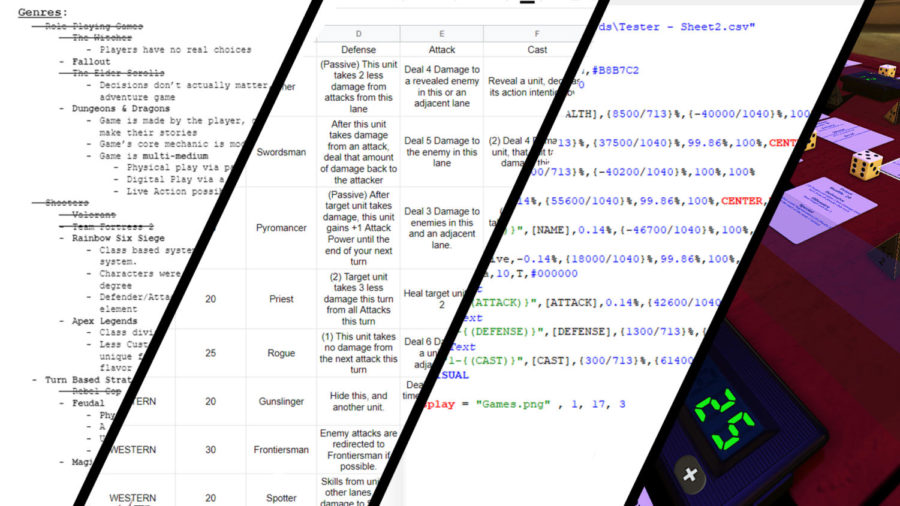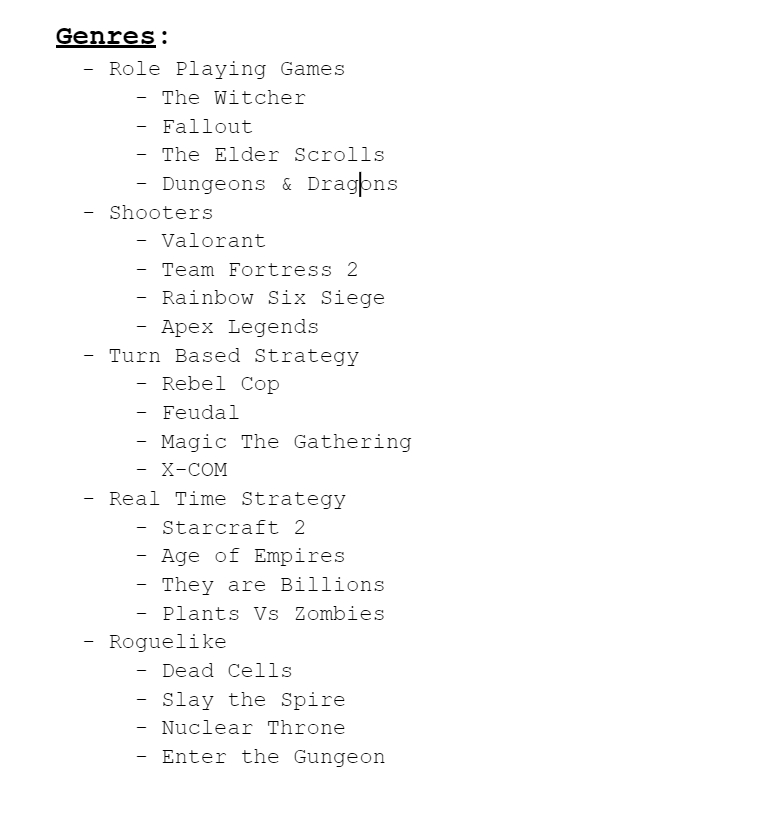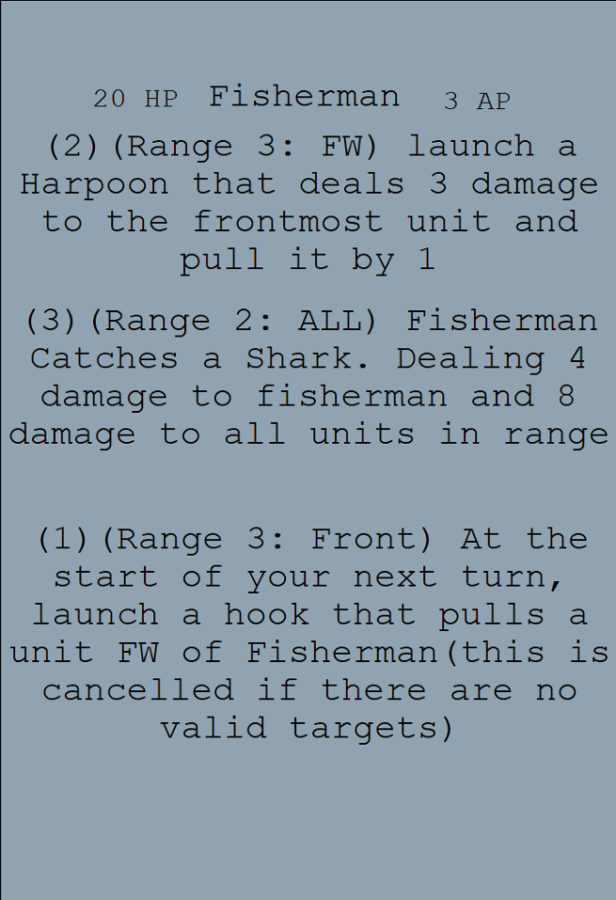Mechanics Loosely Strung: A Guide to Game Design and Making a Game
An in depth guide to making a game, covering designing, drafting, prototyping, and revising.
Here is a step-by-step guide to designing a video game.
About a year ago, I documented the process of me making a very rudimentary game and the process of researching existing games, developing core mechanics, and understanding audiences. But since then, I have learned a lot. I have done further research, play-tested games for others, and even talked to game designers and developers. But most of all, I have spent the year designing, testing, scrapping, and redesigning many games. So let us run down the process of designing a game again, but this time, with more detail.
Step 0: Learning
Before you can start making a game, you need to know a lot of things, not things from experience or things that you would only know after trial and error, but rather general questions that you need to answer and research.
Part 1: Know what you want
Knowing what you want is crucial for any project, but especially important for making a large, multifaceted project like a game. Start by thinking about what you want to make, because depending on the game, you are going to need to do different things for it. For example, if I plan on making a role-playing game, I would need to focus a lot more on story writing and quest and character design; whilst if I plan on making a combat style game, I would need to focus more on level/map design, player interactions, as well as mobility.
To do this, you just need to play games. This is not research, it is learning about yourself. Every day, play a new game if possible, and if you liked the game you played that day, jot it down in a notepad. Do this for many genres, and do it for about five games in each genre you are interested in. Then, start revisiting them, and see if you still like them as much as you did when you first played them. If you do not, drop them from the list. What remains will be games that you like.
Knowing what you want goes a long way, because if you do not start off with a goal, you often end up very far away from your initial goal. This results in games that are either not cohesive, overloaded with mechanics, or just not fun to play. And remember, if you do not know what you like, you will not design something that you like, and as a result, you will end up with something that no one likes.
Part 2: Know the Genre
Now that you know what you want to work with, it is time to learn more about the genre with which you are working.
To start off, do some basic research on what defines the genre you are working with. It is important to know the foundations of the games in that genre, because people who play in those genres often have expectations in terms of game mechanics.
“A card game will always have cards, and a role-playing game will have choices; if you don’t have those mechanics somehow, then you are not in that genre of game,” said Justin Yi Cheng ’23.
Then, play games within the genre to learn more about what these games are like in the first place. If you are making a role-playing game, play popular role-playing games such as Fallout, Pillars of Eternity, or Divinity. If you are making a strategy game, play games like chess, XCOM, and League of Legends. And if you are making a combat style game, play Counter-Strike, Overwatch, and Valorant. While playing, jot down common elements of these games, as you can often imitate or subvert them down the line.
Aside from understanding these genres, it is also important to talk to the communities of players of these games. It is very important to know why people love a certain game and to know what they have problems with in games in the genre.
“If you have serious commercial aspirations, then you need to make sure that your game actually solves a problem in the market,” said Keith Rice, designer of Legacy’s Allure.
Part 3: Know the Audience
Aside from knowing what you want to make, you also need to know who you are making the game for. Different demographics are going to have different wants and needs in a game. A four-year-old will not have the same physical and mental capabilities as a twenty-three year old, so it will be challenging to design a game that is engaging for both groups.
To start off, settle on the platform that you want to attract. Different platforms means different audiences and different restrictions. For example, most mobile games are shorter experiences, lasting on average four to five minutes per level, and are they often quick to restart. They require low commitment. In contrast, most computer games are designed to be more cohesive experiences that may take forty-five minute play sessions and have larger commitment attached to each session. This can help you determine the competitiveness of your game, as people who are looking for mobile games are likely also looking for more casual and relaxed experiences while waiting for the train, and as a result would not be interested in longer 30 minute PVP games.
Second, think about the type of players whom you want to attract. A great resource for this is player psychographics such as Bartle’s Taxonomy of Players, in which players are categorised into four different groups through two axes. In this way of categorization, players are put into groups based on what they want to do in a game. Do they like responding to the game’s world? Well then, they are likely explorers who enjoy exploring tidbits of lore and world-building. Do they like acting upon other players? Well then, they are likely players who enjoy dueling mechanisms and engaging with hordes of enemies. And if they like hunting for achievements and finding secrets, they may be an Achiever. These player archetypes usually help you to define how you implement your mechanics down the line. For example, Explorers and Socializers, are likely more accepting of uncontrollable randomness compared to Players and Achievers, while Achievers and Players are more likely to accept more difficult and slower gameplay.
Third, think about age. Young people are very different from old people. You can try to make a game that is playable for all ages, but people of different ages have different cognitive abilities. For example, elderly people are less likely to play a first person combat game because those games usually require high reaction speeds and analysis skills; however, they would likely love a slower game like bingo. In addition, people of different age groups would also have different opinions on the theme of your game, as every generation would have different levels of exposure towards certain topics.
This type of categorization allows you to both determine major elements of your game. In my current design for a strategy game, I focused on appealing to player action and choice, where every player action can and should lead to different reactions from his opponent. This would mean that I am appealing to people who enjoy player achievement, strategic thinking, as well as long-term plans. This means that I would need to gear my game towards a young-adult to adult audience, and that my mechanics can be action heavy, and ideally without variability.
Step 2: Conceptualization
Now, we reach the hardest and most important step of card game development: the conceptualization step. We have researched the audience and we researched the genre. We can now finally start designing the basic mechanics, themes, and function for the game.
Part 1: Mechanics
One way to design basic mechanics is by painting in broad strokes. Do not think about precise interactions and specific encounters just yet; instead, think about the flow of the game. How does your game start? How does your game end? How long does the game take to play? Through those three questions, you will start developing a basic beginning and end. Then, build everything around and between that.
In my current design, players start with five units and end the game by removing the enemy’s five units. Then, I built around that by answering why and how questions in regards to my end goal. How do I remove the five enemy units? Through combat initiated by your units. How do I initiate combat? Place your units in lanes and have them fight the enemies in those lanes. How do I take less damage? Tell your unit to defend or activate a skill.
Another way to go about this is by building around a core mechanic. Think about what is important for the game — what you want to be prominent and your game’s selling point. Then, think about how to make the mechanic stand out compared to other games out there and how you can connect other mechanics to it.
A great example of this is Crypt of the Necrodancer, an action strategy game that is built around a very simple rhythm-based movement system. Enemies for example, follows the same rhythm the player follows, and boss fights would often have tempos that use their soundtracks as ways of engaging the player. Many weapons also use how well the player has been following the rhythm in order to gain bonuses, and players can even be dropped into the next stage if the song finishes.
Part 2: Flow Testing
After creating the basics, it is time to test whether or not the game flows well. This is the process in which you test the core gameplay loop/experience of design for pacing and smoothness. If a mechanic in your core loop feels disruptive or unnecessary, it is important to trim that part away to help to keep the player’s momentum flowing.
To do this, start off by creating a flowchart using a tool such as Microsoft Paint, Diagrams.net, or even Google Slides. In this chart, mark how to initialise your core gameplay loop. For example, in Magic: The Gathering, players initialise the game by shuffling their decks, deciding who goes first through a dice roll, drawing seven cards, and then performing ‘London mulligans’ if they wish. Then, they separate each action in the game and place it as a block, whenever there is an action that would split the chart, create a branching action. In this part, try to think of your game in the most general way possible by disregarding specific interactions and non-guaranteed interactions. Here is the chart for my current design for reference:
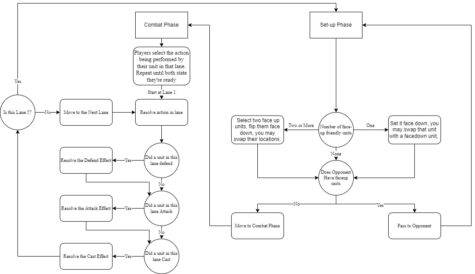
In this sheet, I separated my game into two distinct phases: setup and engagement. Then, I dissected the game into individual decisions/questions. Using those decisions and actions, I was able to create a simple loop and flow for players to move through, in order to understand how the game plays. This flowchart will come in handy when designing game pieces and gameplay elements, as these are what must be implemented before you have a game.
Now, for comparison, here is a flowchart for a previous design of mine which was much more negatively received by testers because of its poor flow:
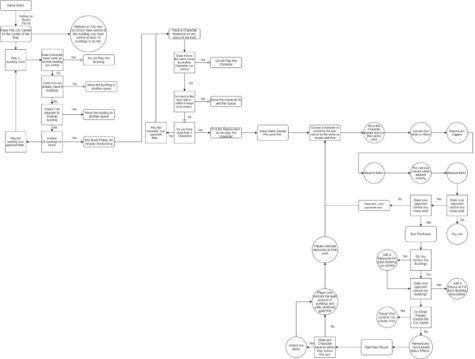
From this diagram, you can clearly see that there is much more complexity with how the game functions, and that is fine (there are always complicated games!). What is not fine in this design, however, is the fact that there were too many elements that just felt unnecessary to the game’s core loop. This resulted in a bloated and hard-to-understand game that did not operate well and resulted in a boring, confusing experience.
Step 3: Designing
With that, we have a functional template for a game. Now it is time for us to develop game pieces, gameplay elements, as well as more specific rules within the game.
The first thing to designing game elements is knowing how you are going to design them. One way is to design for balance, making sure that every element is appropriately powered at their respective levels and that the player with more skill would win 90% of the time. This often results in a very competitive and skill intensive game.
This design often works best for multiplayer games that have a clear ranking system, as the appeal of these types of games is often with ranking. However, this style of design is not good for casual and innovative centered games, as competition stifles creativity by creating the most effective tactics and mandatory strategies. This also creates a bar of entry for new players, as they are forced to learn the meta and cannot progress without a second source. This type of design also requires consistent and frequent updates, in order to make the experience fresh and balanced, as metas often create one dominating play style and makes the gameplay feel repetitive.
The other design method is to design for fun, where all mechanics may not be exactly on the same power level, but they are smooth to pick up and provide unique and creative experiences for the player. This means making gameplay elements non-restrictive, using difficulty to scale with player power, and allowing for the player to make their own decisions. This style of design works best in action games as well as role-playing games, as both game types focus on players taking the game at their own pace and immersing themselves in the world. However, you should avoid this type of design in adventure and strategy games, as this design style often removes intense strategy in favor of maximizing fun for the player. This type of design is also subjective, as different players have different preferences on what they find fun.
And one last method is to design for intrigue, where you design mechanics to be unique and interesting, and give the player full reign to learn and explore the game and its world. This would mean a lot of world-building and innovation with your mechanics and game elements. An example would be Dead Cells, which is a highly challenging hack and slash game that randomizes its levels and item drops. This makes every run unique with enemies and paths encountered different, making the player interested in progressing and playing.
This type of design works best with role-playing games, as the games centre themselves around a progressive loop of learning and improving. However, intrigue-based design does not work with linear games that have no ability for replay, as intrigue-based design depends on the players wanting to learn more, which linear games lose interest after one play through.
In the case of my design, I designed it for both intrigue and balance. This is because my game is a multiplayer game with a higher focus on synergy as opposed to pure competition. I would need to make sure my game pieces (cards) feel unique but not overtly stronger than one another. To make this simpler, I decided to split up my cards into factions, where each faction would have its own gimmick and create synergy with other cards in its own faction. This limits the amount of chaos within each player’s deck, allowing me to balance and to only consider within the confines of their faction.
Part 2: Theme
Now let us move on to the equally important topic of theme. Theme is the general flavor and artistic/world-building within your game — it explains or shows how things work. It can help make sense of certain mechanics and even attract players in the first place.
The importance of theme and flavor is not something to be underestimated. In a survey conducted with the Bronx Science Tabletop Games Club, D&D club, and E-Sports Club, it was noted that an astounding 80% of students found thematic elements (art/story) as a highly important element of why they play games.
Akiva Josephs ’24 said, “The flavor of a game can affect how I perceive the mechanics and what existing strategies I can use to play, and a really good theme can make up for a lackluster game.”
Thematic elements can also impact how people feel about your game. A great example is found in a relatively unknown game known as Call of Juarez: Gunslinger, where you have an unreliable narrator who narrates the story that you play through. During the game, you often find yourself in situations where the only outcome is the game’s end, and your narrator would then change the story in order to make the narration make sense with how the game is playing out. In many reviews of the game, the narrator was cited as one of the biggest reasons to play the game. The story and setting of the game allowed people to find interest in what was, honestly, a relatively standard arcade combat style game.
Thematic elements also help to cultivate certain emotional responses and help the game feel better to play. Tonal mismatches as a result of thematic elements not making sense with the mechanics can cause serious problems with player immersion and satisfaction. An example of this is the latest installment within the Fallout franchise, Fallout 76. In the world of Fallout, you are often living the aftermath of a great nuclear war in an alternate realities atompunk world, and natural elements such as trees and grass are mostly gone within the first sixty years post war. Yet, in Fallout 76, trees and grass were everywhere, which created a tonal and inconsistent mismatch that resulted in many fans unable to connect as much with the game.
Justin Zheng ’23 said, “I love fantasy and immersion, so the world of a game (at least, video games) I find to be pretty important to me, since it allows me to become immersed deeper into the lore of the world and its atmosphere. I get more entertainment value learning the information that there is to learn.” To create an inconsistent atmosphere is to remove a reason why people like to play games in the first place.
To find the right theme for your game, you are going to need to connect your game’s core gameplay to something in the real world. Plants Vs Zombies creator George Fan once said, “Choose a world or make a world that fits as snuggly with your game’s mechanics as possible. If you are making a game where you are jumping from platform to platform and you are trying to not fall into spikes on the bottom of the screen, do not just arbitrarily choose to make the game take place underwater and make the main character a balloon.”
A great example of a game that matches its gameplay to its theme is chess. Chess’s theme is a war between two different kings; the white king has its army and the black king has his army. This theme makes sense with chess’s core gameplay as a strategy game about board control.
The other part about choosing themes is to make sure the theme conveys the goal of the game. In my current design, my overall theme is an inter-dimensional gladiatorial colosseum, and that theme conveys the idea of engaging in combat. If the theme of my current design was instead a marketplace brawl, the game would make less sense, as the orderly and structured movement and fighting in turns just loses its reason.
An example of a game with a theme that does not convey its overall goal is League of Legends, which has separated the game’s core thematic elements from the game itself. League’s overall goal is to destroy the opponent’s nexus. But the problem with this comes from the fact that you, as the character or player, have no reason and are given no thematic reason to want to destroy the nexus. This results in an incoherent and lackluster theme, as new players do not understand why events in the game take place.
Part 3: Intuitiveness
Another aspect of design is your game’s intuitiveness. Although it is feasible to strong-arm the player through a clear tutorial, it is extremely important that you design your game in a way that players follow your rules by nature.
Following mechanics within context and basic logic allows the players to understand and yo learn the game much more effectively.
One way to make your game more intuitive is to piggyback off of common knowledge, as this can help players to understand how something functions without needing a lengthy explanation.
In reference to mechanics in cards from Magic: The Gathering, “The players understood that the bat flies because bats fly. They got that the vampire/bat could choose when to transform because in horror stories, the vampires have this ability. They knew that the transformation could go back and forth because, once again, the source material they already knew told them this,” said Mark Rosewater, the current lead designer of Magic: The Gathering.
In this case, thematic elements such as using bats flying and vampires being able to transform proactively makes sense to the players because of previous exposure to this type of media, and gameplay mechanics like flying also make sense from a logical standpoint, as it is extremely hard for a person with a longsword to hit birds in the sky.
For my current design, I used players’ understanding of vision in order to implement a core gameplay mechanic. In this case, most of my units can only target things with attacks and spells in only the position that they face. This would usually be confusing, as players of grid-based tactics games are usually accustomed to being able to target elements in a 360 degrees fashion. But, when I added the explanation that units can only target what is in their line of sight, players instantly understand why the mechanic exists and how it works.
Phase 4: Prototyping
Now we go onto the part where we actually make the game a reality!
Part 1: Designing the pieces
With all that talk about design, let us start actually making a few pieces for the game! In this part, you are going to need to start dissecting what goes into your game piece, and then design each piece with either a theme or a function.
To show how they differ from each other, I will show off two cards from a design of mine, one with a functional design, but given a flavor later; the other, is a unit with its abilities designed based off of its thematic elements.
The difference between these two cards are nominal before being balanced. Card A (Flavour) is built to be a representation of a fisherman, who has fishing hooks, harpoons and well…fish. This allowed me to develop a set of abilities that are focused on reeling in a harpoon and a fishing hook. And card B (Function) was designed to be a close range fighter who has a leap and light area of effect ability, the flavor of a gladiatorial fighter then slowly developed from its mechanics.
Designing by flavor is usually good when you have a clear story or character you want to depict. This type of design works for many types of game pieces, but it works especially well for flashier, more noticeable elements such as major enemies, player customization, and friendly non-player characters. Designing by mechanics, on the other hand, is usually better for level design, minor enemies, and game systems, where players often expect substance over style.
Part 1.5: DANGERS
Now, this may seem a bit dramatic, but there are a lot of things you should stay away from when designing game pieces.
The first danger is the sponge. The sponge refers to a type of enemy in games whose sole purpose is to be hard to pass by. This usually results in players needing to spend a large amount of resources and time in order to progress past them. You can usually identify sponge enemies by their obscene amount of health and/or armor, as well as a linear/non-progressive move-set. A great example of this is found in the dungeons of the MMO Skyblocks, hosted on the Hypixel network in Minecraft, where many of the bosses are made to be high health, medium attack creatures that have one main gimmick.
Fixing this is relatively easy — give your bosses progression. This means giving your boss unique abilities and having its health bar be a timer as opposed to raw numbers. One game that does this extremely well is Cuphead, where every boss has multiple phases and has boss health as a checkpoint for when the boss changes. This makes bosses with huge health pools fun to engage with, as you are greeted with something new every few moments.
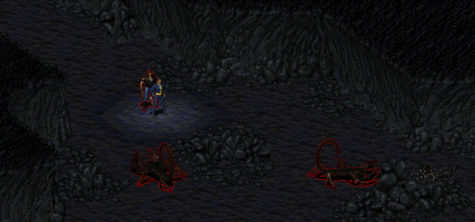
The second danger is enemy metagaming. The term ‘metagaming’ was first defined in tabletop role-playing games and refers to the player using outside/hidden information in order to get an advantage or perform a certain action. The term enemy metagaming refers to the enemy using their understanding of the player. An example is found in the tactical role-playing game, Fallout. In Fallout, enemies are made to target specifically the player character as opposed to any companion that is following them. This results in both illogical gameplay situations, where enemies ignore a dog biting them and instead go after the man eating bread in the corner, as well as frustrating experiences for the player who feels trapped as a result of being constantly ganged up upon.
To fix this, just make your AI/machine players less effective. Although it is very tempting to make effective and strong enemies in order to challenge the player, it is much more important that your players feel that the difficulty level is fair. A game that does this relatively well is Rebel Cops, where although enemies usually outnumber the player five to one, players can out-maneuver the AI with proper tactics.
The third danger is the empty choice. These are the decisions provided to give an illusion of choice to the players but have no impact on how the game actually progresses. Empty choices usually result in both diminished re-playability, as players usually would not want to replay linear story games. This is extremely prevalent in games made by Telltale Games, where despite having major choices within the story, the story progresses the same way for every player no matter the decision made.
A solution is to give your players mechanically similar results but thematically different outcomes. A great example of this can be found in The Outer Worlds, specifically on the planet of Monarch. On this planet, you have the option of supporting two factions, and would receive similar rewards no matter who you support. But your support does impact how certain characters regard you and how the town looks on revisit. This makes your choice feel more meaningful, even though it has no major impact on how the game is played.
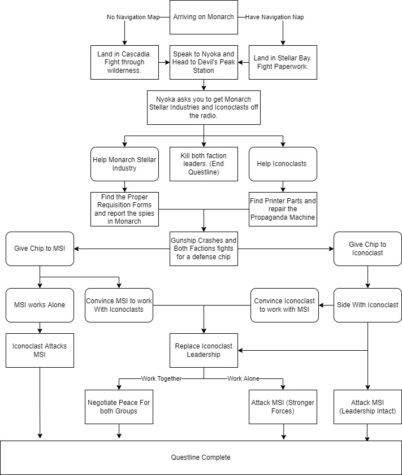
Part 2: Formatting
Now it is time to solidify your ideas. Using your flowchart from earlier, make a list of essential mechanics and content that your game needs in order to be played. This includes both major elements such as the game system and plot, and minor elements like inventory systems or user interfaces. Then, dissect these elements.
For example, a major element of my game are the game pieces that players play with. So I would dissect the game pieces into fields of data such as name, health, skill one, skill two, and skill three, and then use these fields to structure and standardise card designs. I suggest using a spreadsheet for this, as it allows you to create format data and export them for layout tools.
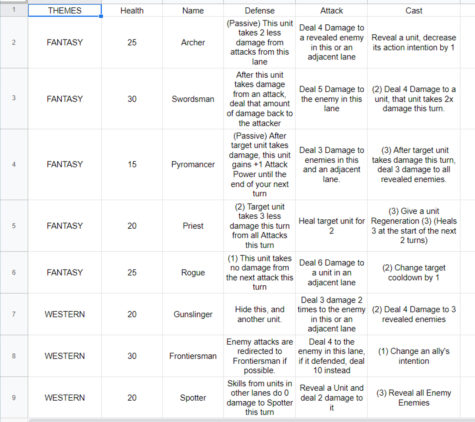
Part 3: Creating the prototype
The steps to creating a prototype diverge slightly depending on the platform you are using and your proficiency in programming and design, but the major difference is between paper and digital prototyping.
Prototyping on paper
Paper prototypes are relatively easy to produce. You can use the spreadsheet from earlier as well as the template, plug it into a page layout tool such as Adobe Indesign or nanDeck, format the game pieces as you wish using the visual editor, and then print them out on cardstock or printer paper. You can then find play testers in the real world, such as friends and family, or players at a local game store.
Two very popular online simulators are Tabletop Simulator and Tabletopia, both physics-based board game simulators that allow players to insert and add in their own game elements and play around with them as if they were real world objects. These simulators allow you to test digitally and foster a community around your game much more easily as well.
Prototyping digitally
Making a digital prototype is a lot more complicated than making a paper prototype, as making a video game usually requires a good understanding of programming as well as the game engine you are working with. However, all hope is not lost, as there is a very simple, albeit limited, way of making a prototype: Scratch.
Scratch is a block-based coding platform made by the Massachusetts Institute of Technology in order to teach children the basics of programming. Although the platform is more limited in tools than professional game development engines such as Unity (C# based engine) or Unreal (C++ based engine), it offers an easy-to-navigate interface and an easy-to-understand structure for complete beginners in programming.
With scratch and your previous flowchart, you can start programming the basic game loop and. Do not worry about art or anything else at this point.
Part 3.5: Rule Writing.
The second part to prototyping is writing the rules of the game. Writing rules is extremely important as it tells your players how to play and resolve interactions. Rulebooks in the digital sense are tutorials.
The first step to writing rules is denoting a goal. The purpose of your tutorial should be to get the player’s mind into your game. You want to grab the reader’s attention and immerse them into the world you have created. The mechanics of the game should act as the tool to experience this world.
A great way to start is with a short, narrative paragraph or a cutscene where the context of the world is displayed. This allows the player to adapt to the game’s theme and wording. This should not be an essay — it should be a simple paragraph that answers the questions: “Who are we, where are we, and what is our goal?”
If you are making a physical game, you should also present to the reader how your game should physically be placed on the table. And a very important side note: Encourage them to follow along! This will not only make them read your rulebook, but also get them interested and ready for your game. And In the context of a video game, this is your tutorial, where you are teaching your players how to play step by step.
Then, create a quick overview of how your game is structured. Does your game feature rounds? Are rounds divided into turns? What are the core mechanics of the game? In the context of a video game, this is your quick start guide and tooltips. In the context of a board or card game, this means a rulebook or ‘how to start’ guide.
Phase 4: Testing
The first thing is a self test. Play the game for yourself, and, if you must, act as both players. In this step, you are primarily looking for elements that feel detached from the experience you are trying to create and mechanics that feel awkward with the game’s pacing and structure. Examples include bosses that feel out of place, mechanics that feel counterintuitive, and game content that feel lackluster. You can also look for overpowered game cards or things that felt not fun, but those things are slightly more subjective and should be left to public tests.
Then, test with a friend. If you know someone close to you who enjoys playing games, ask them to test it out for you. During this test, you should take careful notes about what your tester did and did not like as well as if they thought the game rules felt intuitive. You should also ask if they understood the purpose of every element in your game. You should do this with several friends if possible, and then take down their suggestions.
After testing with friends, test with people who are not familiar with your game. Start off by finding an audience. This could mean going to board game prototyping conventions such as Protospiel, going to forums such as Reddit’s r/playmygame, or even going to clubs and game shops near you to ask for new opinions.
Before you start playing, gather an informational profile of your play tester. Take note of what kind of games they play, how old they are if possible, their preferences in game themes. During this test, you should take careful notes about what your tester liked and whether they are able to pick up the game easily.
With public testing, it is important to start small. Test with people in one-on-one sessions, gather feedback, and slowly grow from there. You want to foster a community where you can discuss your designs and ideas. Then, once you have enough play testers, start a tournament and have players build their own strategies. This allows you to see the meta, or most effective, tactic available and determine whether they stifle creativity or design space for the players.
Phase 5: Revision
The revision process is where you take what you learned from testing and playing the game and apply it to your design. In this process, you should look at game content and mechanics that appeared problematic or were complained about by play testers.
Part 1: Rebalancing

The first step is to rebalance those elements. If a unit is too dominant in power, try small nerfs in numbers and target exactly what made that card strong. Do not remove any mechanics yet, as minor rebalances are usually enough to fix a card and unwarranted reworks could lead to even more issues down the line.
Part 2: Reworking
If rebalancing does not work, it is time to rework the mechanism. This means slightly changing how the mechanic functions or adding onto your mechanic, giving it a new functionality. This does not mean changing miniscule numbers, but rather making a bigger functional change.
For instance, in my game, I had to add an Armou mechanic. For many players, there was a lack of value to positioning and as a result, it felt gimmicky and unnecessary. Therefore, I added an armor mechanic that reworked and redesigned the turning system, making it much more fun and interactive.
Part 3: Replace/Remove
If rebalancing and reworking does not work, it is time to remove the idea and replace it with something else. Not every mechanic will be a success, you will have to throw out some ideas now and then. But when you do, make sure you have a good replacement or a good reason for removing it. You should not leave a hole in your game.
Congratulations, you now have a functional game! Now, it is time for you to think about what to do with it. There are many different ways of going about it, but the best thing to do is usually putting your game out there and getting feedback. This could mean properly publishing your game by pitching it to a publisher or starting a kickstarter campaign. You could also self publish your game by putting it on websites such as Itch.io or Gamejolt, platforms that allow indie developers to publish their games and get easy feedback through a comment section. But, if all else fails? Go back to the beginning of the article, and go through this process again.
Let us run down the process of designing a game again, but this time, with more detail.
Tiankuo Zhang is an Editor-In-Chief for 'The Science Survey.' He sees journalism as something that has withstood the test of time and finds the transcriptions...

